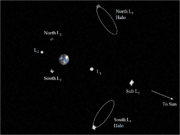Artificial Lagrange Orbits
From SolarSailWiki
When a planet orbits a star, or a moon orbits a planet, there are Lagrange points where gravity and centrifugal acceleration from the smaller body's orbital motion balance. Spacecraft and natural objects, like asteroids, may orbit these points. The thrust of a solar sail can change the location of the balance point, and where a spacecraft can orbit. These new artificial Lagrange orbits (ALOs) enable a unique perspective for a variety of applications.
Contents |
Planetary Artificial Lagrange Orbits
Solar sails enable periodic orbits displaced from the natural Sun-planet Lagrange points. [1]
Lunar Artificial Lagrange Orbits
Solar sails enable periodic orbits displaced from the natural Lunar lagrange points. [1, 2, 3, 4]
See Also
References
- McInnes, Colin R. Solar Sailing. Springer-Praxis, Chichester, UK, 1999. BibTeX
- Simo, J and McInnes, C R. Solar sail trajectories at the Earth-Moon Lagrange points. 59th International Astronautical Congress (IAC'08), 29 Sep - 3 Oct 2008, Glasgow, Scotland , 2008. BibTeX
- Simo, Jules and McInnes, Colin R. Solar sail orbits at the Earth-Moon libration points. Communications in Nonlinear Science and Numerical Simulation 14(12):4191 - 4196, 2009. BibTeX
- Simo, J and McInnes, C R. Asymptotic analysis of displaced lunar orbits. Journal of Guidance, Control and Dynamics 32(5):1666-1671, 2009. BibTeX
